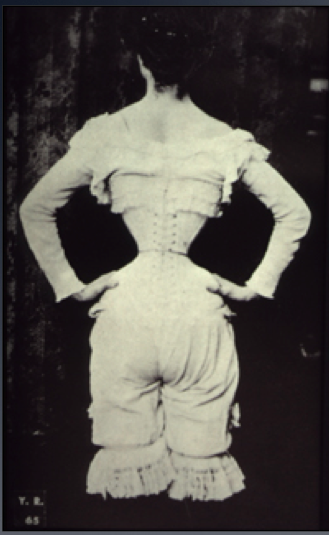Wasp waist on:
[Wikipedia]
[Google]
[Amazon]

 Wasp waist is a women's fashion silhouette, produced by a style of
Wasp waist is a women's fashion silhouette, produced by a style of

 Wasp waist is a women's fashion silhouette, produced by a style of
Wasp waist is a women's fashion silhouette, produced by a style of corset
A corset is a support garment commonly worn to hold and train the torso into a desired shape, traditionally a smaller waist or larger bottom, for aesthetic or medical purposes (either for the duration of wearing it or with a more lasting eff ...
and girdle, that has experienced various periods of popularity in the 19th and 20th centuries. Its primary feature is the abrupt transition from a natural-width rib cage
The rib cage, as an enclosure that comprises the ribs, vertebral column and sternum in the thorax of most vertebrates, protects vital organs such as the heart, lungs and great vessels.
The sternum, together known as the thoracic cage, is a sem ...
to an exceedingly small waist, with the hips curving out below. It takes its name from its similarity to a wasp
A wasp is any insect of the narrow-waisted suborder Apocrita of the order Hymenoptera which is neither a bee nor an ant; this excludes the broad-waisted sawflies (Symphyta), which look somewhat like wasps, but are in a separate suborder ...
's segmented body. The sharply cinched waistline also exaggerates the hips and bust
Bust commonly refers to:
* A woman's breasts
* Bust (sculpture), of head and shoulders
* An arrest
Bust may also refer to:
Places
* Bust, Bas-Rhin, a city in France
*Lashkargah, Afghanistan, known as Bust historically
Media
* ''Bust'' (magazin ...
.
History
In the 19th century, while average corseted waist measurements varied between , wasp waist measurements of were uncommon and were not considered attractive. Ladies' magazines told of the side effects of tight lacing, proclaiming that "if a lady binds and girds herself in, until she be only twenty-three inches, and, in some cases, until she be only twenty-one inches, it must be done at the expense of comfort, health, and happiness." Fashions instead created the illusion of a small waist, using proportion, stripe placement, and color. Retouching photographs was sometimes used to create the illusion of a wasp waist. Extreme tight lacing () was a fad during the late 1870s and 1880s, ending in around 1887.Health effects
Among the multitude of medical problems women suffered to achieve these drastic measurements were deformed ribs, weakened abdominal muscles, deformed and dislocated internal organs, and respiratory ailments. Displacement and disfigurement of the reproductive organs greatly increased the risk ofmiscarriage
Miscarriage, also known in medical terms as a spontaneous abortion and pregnancy loss, is the death of an embryo or fetus before it is able to survive independently. Miscarriage before 6 weeks of gestation is defined by ESHRE as biochemica ...
and maternal death
Maternal death or maternal mortality is defined in slightly different ways by several different health organizations. The World Health Organization (WHO) defines maternal death as the death of a pregnant mother due to complications related to pre ...
.
See also
*Corset controversy
The corset controversy concerns supporters' and detractors' arguments for and against wearing a corset. The controversy was contemporary with the time that corsets were popular in society. Corsets, variously called ''a pair of bodys'' or ''stays ...
* Foot binding
* Tightlacing
Notes
19th-century fashion 20th-century fashion Corsetry {{fashion-stub